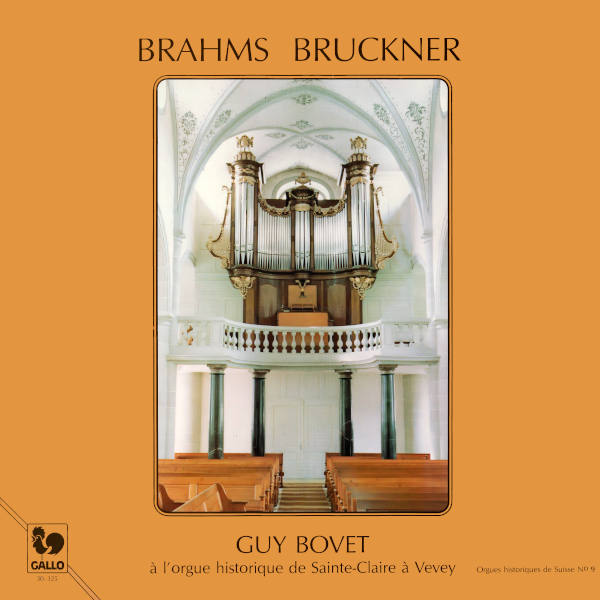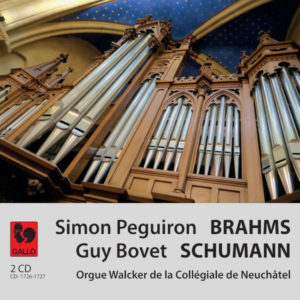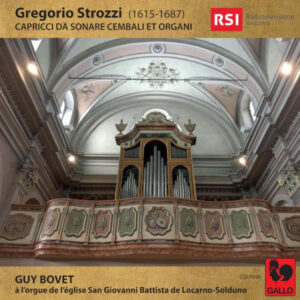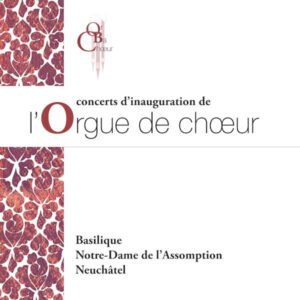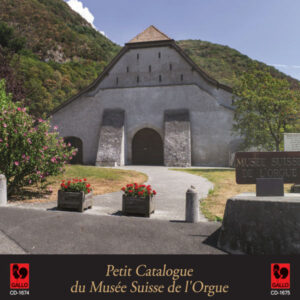Extraits / Excerpts
Brahms: Choral Preludes, Op. 122 - Bruckner: Praeludium in C Major, WAB 129 "Perger Praeludium" - Guy Bovet at the historic Sainte-Claire Organ in Vevey.
Johannes BRAHMS: 11 Choral Preludes, Op. 122: No. 1 Mein Jesu, der du mich – Choralvorspiel und Fugue über “O Traurigkeit, o Herzeleid”, WoO 7: Choralvorspiel – 11 Choral Preludes, Op. 122: No. 2 Herzliebster Jesu – No. 3 O Welt, ich muss dich lassen – No. 4 Herzlich tut mich erfreuen – No. 5 Schmücke dich, o liebe Seele – No. 6 O wie selig seid ihr doch, ihr Frommen – No. 7 O Gott, du frommer Gott – No. 8 Es ist ein Ros’ entsprungen – No. 9 Herzlich tut mich verlangen – No. 10 Herzlich tut mich verlangen – No. 11 O Welt, ich muss dich lassen – Anton BRUKNER: Praeludium in C Major, WAB 129 “Perger Praeludium”.
Guy Bovet at the historic Sainte-Claire Organ in Vevey.
Brahms has bequeathed to us fifteen pieces for organ. Three of them are “free” pieces (two preludes and fugues and one fugue in A flat minor, written at the age of 23 and 24); the twelve others are choral preludes, written at the very end of the Master’s life, with the exception of ‘O Traurigkeit’ which dates from the same epoch as the free pieces. It is these chorals that are the object of the present recording.
Their atmosphere is serious, serene, but it reveals the thought of a lonely, aged Brahms, thinking of death. The musical references are clearly readable: J.S. Bach is continually present; but also in Brahms’ own production, one finds the atmosphere of these chorals in the ‘Vier ernste Gesange’ or in certain passages of the ‘Deutsches Requiem’. These posthumous pieces (with the exception of ‘O Traurigkeit’), published as opus 122 in 1902, might well be the musical testament of the composer; Brahms, in his last years, returns to the organ, which he had completely abandoned for 42 years, and writes for that instrument eleven pieces of extreme beauty and simplicity.
11 Choral Preludes Op. 122, No. 1: Mein Jesu der du mich
‘Mein Jesu der du mich/zum Lustspiel ewiglich/Dir hast erwahlet
sieh wie dein Eigentum/des grossen Braut’gams Ruhm/so gern erzahlet.’
In spite of this text, which evokes the joy of a Christian in comparison to that of a bride, the atmosphere of the choral is calm (Brahms’ indication: ‘forte ma dolce’). Each phrase of the choral is introduced in fugato, in an ornate version, before ever the pedal emphasizes it in long values. The art of the counterpointist is remarkable. The idea of ‘love play’ (‘Lustspiel’) is indicated in the preparation for the third phrase, where a theme in arpeggios with a phrase displacing the rhythmic accent emerges and surrounds the subject. As the last phrase begins, the piece is enriched with an additional voice, increasing the harmonic density.
O Traurigkeit (composed 1857, published 1882)
‘O Traurigkeit/o Herzeleid/ist das nicht zu beklagen/
Gott des Vaters einig Kind/wird ins Grab getragen.’
This piece, the density of which is certainly comparable to that of op. 122 chorals, is nevertheless a part of the series of pieces written at the epoch when Brahms revised his studies of counterpoint by studying the organ works of Bach. At the same time, he competed with Clara Schumann in organ studies, which led to an amorous friendship that left its traces in the whole life of the composer. In point of fact, it concerned a prelude and fugue. In the first, the choral melody is introduced in the soprano, on a solo stop, accompanied by a quiet movement in triplets. At the end, as an echo, the first phrase is repeated in the sub-dominant key, decrescendo. The fugue is once more very solidly structured, but still remains very tuneful. Here again we find numerous inversions of the subject, likewise also a counter-subject in ascending sixths adding an expressive element. As in the preceding choral, the theme is given in the bass, in long values. This piece is dedicated to a pupil of Brahms, Friedchen Wagner.
[show_more more=”Show More” less=”Show Less”]
11 Choral Preludes Op. 122, No. 2: Herzliebster Jesu
‘Herzliebster Jesu/was hast du verbrochen/dass man ein solch scharf Urteil hat gesprochen/Was ist die Schuld?/in was für Missetaten/Bist du geraten?’
Here the subject is given in the soprano, slightly ornamented. It is accompanied by a syncopated movement, groups of three quavers without a downbeat, the pedal frequently giving a theme descending at a Tritonus interval (a similar theme is found in the choral ‘Durch Adams Fall’ in the Orgelbüchlein of Bach, symbolizing the fall of Adam). The atmosphere diffuses a strong, vigorous indignation. It is a piece of a dramatic rather than passive nature.
11 Choral Preludes Op. 122, No. 3: O Welt, ich muss dich lassen
‘O Welt, ich muss dich lassen/ich fahr dahin mein Strassen/ins ewge Vaterland/Mein Geist will ich aufgeben/dazu mein Leib und Leben/befehle in Gottes Gnäd’ge Hand’
Theme in the soprano, rather ornamented. The accompaniment is in ‘sigh motives’: groups of two notes, rising or falling often to be found also in Bach (O Lamm Gottes unschuldig, and many other chorales) when he desires to convey the idea of suffering. In the last phrase, Brahms increases the ornamentation, leaving and returning to the same note four times, in a manner very common to him; no other could have been able to write that ending.
11 Choral Preludes Op. 122, No. 4: Herzlich tut mich erfreuen
‘Herzlich tut mich erfreuen/die liebe Sommerzeit
wenn Gott wird schön verneuen/alles zur Ewigkeit
Den Himmel und die Erde/wird Gott neu schaffen gar
all Kreatur soll werden/ganz herrlich hübsch und klar’
This slightly joyful piece is entirely written in arpeggios: seeming to relate to the piano rather than the organ. The theme is in the soprano, without ornamentation. In some places, the somewhat hazy effect of the arpeggios is further enhanced by the simultaneous combination of voices arranged in off-beats, a process often found in Brahms’ orchestration.
11 Choral Preludes Op. 122, No. 5: Schmücke dich, o liebe Seele
‘Schmücke dich, o liebe Seele/lass die dunkle Sündenhöhle
komm ans helle Licht gegangen/fange herrlich an zu prangen!
Denn der Herr voll Heil und Gnaden/will dich jetzt zu Gaste laden
der den Himmel kann verwalten/will jetzt Herberg in dir halten.’
A gentle light illumines the piece, the theme in the soprano, without ornamentation, and supported by two voices responding to each other, in semiquavers, On a motive derived from the first phrase of the choral.
11 Choral Preludes Op. 122, No. 6: O wie selig seid ihr doch, ihr Frommen
‘O wie selig seid ihr doch, ihr Frommen
die ihr durch den Tod zu Gott gekommen
Ihr seid entgangen aller Not, die uns noch hat gefangen.’
Theme in the soprano. Counterpoint somewhat complicated, but always fluid, evoking the unhappy ties that hold us in bondage. A final crescendo terminating on a brilliant D major symbolizes ultimate freedom.
11 Choral Preludes Op. 122, No. 7: O Gott, du frommer Gott
‘O Gott, du frommer Gott/du Brunnquell aller Gaben
ohn’ den nichts ist was ist/von dem wir alles haben
gesunden Leib gib’ mir/und dass in solchem Leib
ein unverletzte Seel/und rein Gewissen bleib!’
The texture of this choral recalls certain piano pieces of Brahms with a rhythmic formula used frequently by him (two groups of voices answering each other in dotted rhythms). In the preparation preceding the introduction of the theme, certain expressive inflections are repeated like supplications. The theme appears at different pitches, mostly in the soprano. Towards the end, the supplication motives become more and more expressive, then the piece seems to die, as if the suppliant were exhausted. But in turn, the last phrase is loud, confident that the prayer will be granted.
11 Choral Preludes Op. 122, No. 8: Es ist ein Ros’ entsprungen
‘Es ist ein Ros’ entsprungen/aus einer Wurzel zart
wie uns die Alten sungen/von Jesse war die Art
und hat ein Blümlein bracht Mitten im harten Winter/wohl zu der halben Nacht.’
The Christmas Season is evoked in this choral whose atmosphere contrasts with that, more gloomy, of the majority of the others. This pastoral, soft, piece introduces us to a very ornate theme, often concealed in the tenor. Thus is the mystery of the incarnation of Christ, come on Earth at Christmas; thus is his hidden presence, although constant.
11 Choral Preludes Op. 122, No. 9 & No. 10: Herzlich tut mich verlangen
‘Herzlich tut mich verlangen/nach einem selgen End
weil ich hie bin umfangen/mit Trübsal und Elend
Ich hab Lust abzuscheiden/von dieser argen Welt
sehn mich nach ewgen Freuden/o Jesu, komm nur bald!’
These two chorals form the heart of this cycle and they therein express most directly its philosophy. The composer’s prayer asking to leave this world is expressed in two different ways: the first one, intense, strong. The theme is ornated in the upper voice, but on the same keyboard as the accompaniment, whose texture is similar to it: a form clearly invented by Brahms, while Bach is recalled to us in the rhythmic ostinato of the pedal. The second one, sublime, features the theme in the tenor, in a texture of arpeggiated semiquavers mingled with repeated notes in the Bass, a movement which seems inexorable and continuous, and dies little by little. This piece is one of those nearest to Brahms’ pianistic language, with characteristic parallel sixths and harmonic false-relations movements.
11 Choral Preludes Op. 122, No. 11: O Welt, ich muss dich lassen
‘O Welt, ich muss dich lassen/ich fahr dahin mein Strassen/ins ewge Vaterland/Mein Geist will ich aufgeben/dazu mein Leib und Leben/befehln in Gottes gnad’ge Hand’
To sum up the whole suite of chorals, this piece introduces us to the theme in a series of triple echoes, as if a voice was reaching us from an ever-longer distance. At the end, a brief final interlude recalls the German Requiem of the composer. The cycle ends in a luminous and mysterious peace.
Prelude in C major, Anton Bruckner
Here we forget the legendary disputes which opposed Brahms to Bruckner, surrounded by their partisans, in order to add to this recording a short piece of 27 measures, but whose intensity and symphonic quality form a veritable chef-d’oeuvre. One’s ear has to be well attuned to the Symphonies to well ‘orchestrate’ this organ piece, because it is extremely subtle, in spite of its apparent simplicity. The organ of Sainte-Claire, even thought it is not a great symphonic instrument, has all the necessary qualities to interpret this music. The piece, published posthumously, is dedicated to Mr. Joseph Dierndorfer, one of Bruckner’s admirers, and probably dates 1884, when the composer was in his sixties.
Guy Bovet
[/show_more]
- Categories
- Composers
- Interprets
- Booklet
